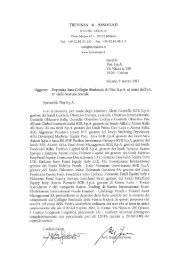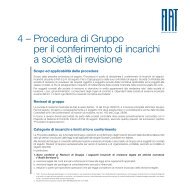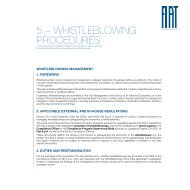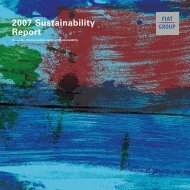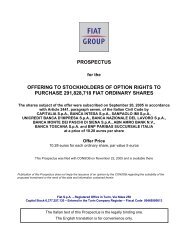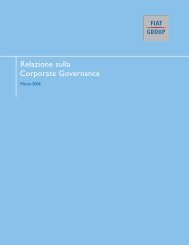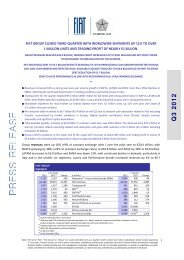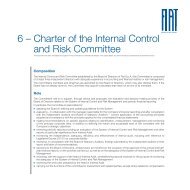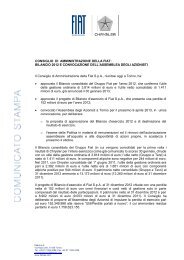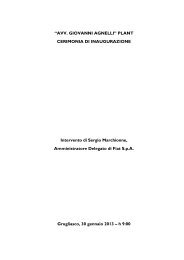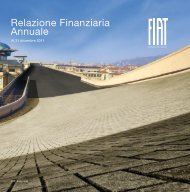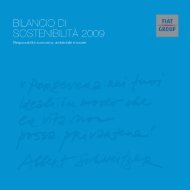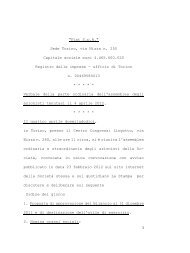annual report - FIAT SpA
annual report - FIAT SpA
annual report - FIAT SpA
You also want an ePaper? Increase the reach of your titles
YUMPU automatically turns print PDFs into web optimized ePapers that Google loves.
have been prepared in accordance with accounting principles generally accepted in the United States of America<br />
(“US GAAP”). The following tables reconcile the loss and members’ deficit as published by Chrysler and the<br />
corresponding balances prepared in accordance with International Financial Reporting Standards (“IFRS”), as<br />
adopted by the Fiat Group, for the above-mentioned periods:<br />
At<br />
30 September<br />
At<br />
01/01-30/09/2010 (*)<br />
2010(*) 10/06-31/12/2009 31 December 2009<br />
Members<br />
Members<br />
(€ million) Profit/(loss)<br />
Interest Profit/(loss)<br />
Interest<br />
Prepared in accordance with US GAAP (344) (2,816) (2,614) (2,936)<br />
Reconciling items on:<br />
Development costs 358 495 132 133<br />
“VEBA Note” and “VEBA Trust’s Contribution” (22) 1,131 1,416 1,756<br />
Pension funds and other post-retirement benefits - 662 - 634<br />
Other minor adjustments 21 24 4 3<br />
Prepared in accordance with IFRS<br />
(*) Unaudited.<br />
13 (504) (1,062) (410)<br />
Main reconciling items refer to:<br />
� Development costs: under US GAAP, all development costs are expensed as incurred. Under IFRS,<br />
development costs for vehicle project production are capitalised as intangible assets if the development costs<br />
can be measured reliably and the technical and economic feasibility of the product, volumes and pricing<br />
support the view that the development expenditure will generate future economic benefits. Capitalised<br />
development costs include direct and indirect costs that could be directly attributable to the development<br />
process, incurred by Chrysler starting from 10 June 2009. These costs are subsequently amortised on a<br />
straight-line basis over the production cycle.<br />
� VEBA Note and VEBA Trust’s Contribution: the reconciling item includes differences in the accounting<br />
treatment of the financial liability (“VEBA Note”) of Chrysler to the United Auto Workers’ Retiree Medical<br />
Benefits Trust (the “VEBA Trust”) that results from the settlement of the cumulative post-employment benefits<br />
due to certain retirees of the previous Chrysler (“Old CarCo LLC”, now in liquidation). The reconciling item also<br />
includes the different valuation of the VEBA Trust’s contribution to Chrysler equity. Under US GAAP, the<br />
settlement of the other post employment benefit obligation was recognised on 1 January 2010, as those<br />
accounting principles do not recognise partial settlements. Under IFRS, a partial settlement of the other post<br />
employment benefits obligation was recognised on 10 June 2009. The reconciliation adjustment results from<br />
differences in fair value measurement of the VEBA note payable and equity consideration resulting from<br />
different settlement dates on which the valuation was performed. The effect on equity resulting from the<br />
different accounting treatment of the VEBA Note will reduce substantially over time, over the term of the Note,<br />
with a corresponding entry to profit or loss for the period.<br />
� Pension funds and other post-retirement benefits: under US GAAP, Chrysler immediately recognises actuarial<br />
gains and losses for other post employment benefits plans which are short-term in nature and for which its<br />
obligation is capped. For uncapped plans, Chrysler’s US GAAP accounting policy is to utilise the 10% corridor<br />
approach. Unrealised actuarial gains and losses are recognised in accumulated other comprehensive loss, a<br />
separate component of equity. Under IFRS, the company also applies the corridor approach. However under<br />
IFRS, the cumulative actuarial gains and losses unrealised are not recognised in the balance sheet. Therefore,<br />
a reconciliation adjustment is reflected to reverse unrealised actuarial net losses from equity and decrease the<br />
provision.<br />
For completeness, it is noted that having reached one of the predetermined so called Performance Events envisaged<br />
in the Chrysler-Fiat strategic alliance agreements, on 10 January 2011 Fiat received without consideration an<br />
additional interest of 5% in Chrysler, and therefore its total holding in Chrysler is currently equal to 25%. Further<br />
details about the Fiat Group’s rights relating to the investment in Chrysler may be found in Note 29.<br />
Non-current financial receivables<br />
At 31 December 2010, non-current financial receivables of €40 million (€44 million at 31 December 2009) wholly<br />
classified as Discontinued Operations were pledged as security for loans.<br />
Fiat Group Consolidated Financial Statements at 31 December 2010 159



